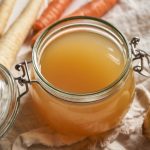Description
Follow this step-by-step recipe for a rich and flavorful beef broth is a rich and flavorful that adds depth to soups, stews, and sauces. Made with high-quality ingredients and preserved to perfection, this recipe ensures high-quality results.
Ingredients
Scale
- 6 pounds beef stock bones
- 2 medium onions, quartered
- 4 medium carrots, diced
- 3 bay leaves
- 3 sticks of celery, diced
- 1 cup warm water
- 3 cloves of garlic
- 1 teaspoon of dried thyme
- 3 to 4 sprigs of fresh parsley
- 8 to 10 whole peppercorns
- 1 teaspoon of dried oregano
- Apple cider vinegar (5%)
- Cold water
- Salt and pepper to taste
Instructions
- Preheat oven to 450°F. Bake the soup bones in a large roasting pan uncovered for 30 minutes.
- Add carrots, celery, and onions. Bake for 30 minutes and drain fat.
- Transfer the bones and vegetables using a slotted spoon to a large stockpot, instant pot, or Dutch oven.
- Add warm water to the roasting pan; use a wooden spoon to loosen any meat residue stuck in the pan.
- Transfer pan juice into the pot.
- Add herbs and seasonings and cover with cold water.
- Bring the mixture to a boil over medium-high heat (about 30 minutes).
- Sterilize your canning jars, lids, and rings. Use your dishwasher’s sterilization cycle or boiling water and dish soap for the jars. Wash the canning lids and rings in warm, soapy water.
- Reduce heat on the broth and simmer uncovered for 4-5 hours, skimming off any foam. Add water to keep ingredients submerged, if necessary.
- Remove large beef bones and chunks of meat from the broth using tongs.
- Strain the remaining broth through a cheesecloth-lined colander.
- Let it stand for a few minutes, and discard any meat, vegetables, or seasonings that have gathered on the cloth.
- Skim all the fat off and discard as it can affect the jar sealing inside the canner.
- Put 2-3 inches of water into the pressure canner and place it over low heat.
- Pour the broth into the canning jars using a funnel, leaving 1-inch headspace.
- Use a spatula or bubble remover to remove air bubbles inside the jars.
- Add the lids and rings and tighten until fingertip-tight.
- Transfer the jars to the pressure canner using canning tongs, leaving space between the jars and the edges of the canner. Process pints for 20 minutes and quarts for 25 minutes per elevation and canner type:
Dial-Gauge Pressure Canner
- 0 – 2,000ft: 11 lbs
- 2,001 – 4,000ft: 12 lbs
- 4,001 – 6,000ft: 13 lbs
- 6,001ft and up: 14 lbs
Weighted Gauge Pressure Canner
- 0 – 1,000ft: 10 lbs
- 1,001ft and up: 15 lbs
Post Processing
- When the time is up, allow the pressure canner to depressurize naturally before using tongs or a jar lifter to transfer the jars carefully onto a clean, cushioned surface to cool at room temperature for 12-24 hours.
- Remove the screw bands from the jars and check the seals by ensuring the center of each lid does not flex when you press on it. If any seem loose or fail the flex test, transfer those jars to the refrigerator and consume them within a week.
- For all properly sealed jars, label the jars with the canning date and contents and store them in a cool, dry place away from direct sunlight.
Notes
When selecting beef bones, you may use marrow bones, veal bones, neck bones, oxtails, shank bones, or knucklebones.
- Prep Time: 20 minutes
- Canning Time: 25 minutes
- Cook Time: 7 hours
Nutrition
- Serving Size: 240g
- Calories: 17kcal
- Sugar: 0g
- Sodium: 893mg
- Fat: 0.5g
- Saturated Fat: 0.3g
- Carbohydrates: 0.1g
- Fiber: 0g
- Protein: 2.7g
- Cholesterol: 0mg
